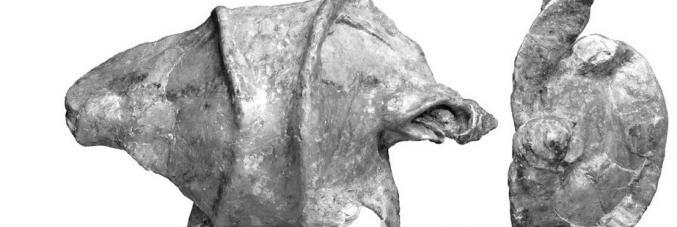
Nature’s secrets of gigantism enclosed in a shell
22.02.2021
Cowries are par excellence: with hundreds of know living species that prefer tropical seas, the shells of these creatures are most coveted by collectors due to their aesthetic beauty and colourful appearance.
The largest specimen of Cypraeidae was recently found in Veneto near a quarry located in the village of Passagno (province of Treviso). The discovery of the 33 cm long fossil shell makes this shell the largest by far from all its competitors, since the largest living one is about 13 cm long, and, until now, the record among the fossils was 28 cm.
Luca Giusberti of the Department of Geosciences of the University of Padua says, "The fossil from the Cypraeidae species (Vicetia bizzottoi) is the largest ever found and dating back between 38 and 34 million years ago. The discovery was uncovered from an abandoned clay quarry located in Possagno in the province of Treviso about fifteen years ago by a passionate paleontophile, Bruno Bizzotto. After necessary restorations, the fossil was stored at the Museum of Geology and Palaeontology of the University of Padua. The find remains at the museum until a project to review the fossil mollusc fauna of the Eocene del Veneto, directed by the University of Florence in collaboration with the University of Padua the allows it to be "rediscover," enhancing its exceptionality. Such studies could contribute to the enhancement of the old quarries of Possagno, which are rich in fossils waiting to be studied, but are unfortunately destined to be restored, thus subtracting them from science and public use as potential geographical features.”
The Museum of Geology and Palaeontology of the University of Padua, where it is currently held after careful restoration, has turned to the Museum of Natural History of the University of Florence to study the precious specimen. The specimen, which, among other things, is also a new species, characterized by its remarkable and very particular bumps of the shell, hence the publication in the journal Scientific Reports. The paper entitled, The largest known cowrie and the iterative evolution of giant cypraeid gastropods that factors led to the evolution of this giant species among many in its group.
"We compared the fossil between the collections of other Cypraeidae species from the Museum of Natural History of the University of Florence and those of Padua,” explains research coordinator and curator of the Museum of Geology and Palaeontology Stefano Dominici, “and compared the data with those of scientific literature. We found that gigantism has appeared several times in the evolution of the cowry. Gigantism occurs for a particular form of selection, called 'species selection’, which was first described by Niles Eldredge and Stephen Jay Gould in 1972 that is of general interest in evolutionary biology.
The study revealed that these giants evolved at the extreme limits of the diffusion area of the group to which they belong, in deeper or colder waters, where oxygen dissolves in greater quantities.
Stefano Dominici continues to explain, "Therefore, cowries respond to the so-called ‘Bergmann’s rule’ that states a phenomenon whereby as the temperature decreases the size of the species increases, individuals become mature at a later interval and live longer. Among the many conditional factors of this rule, verified in many living marine animals, such as whales, but rarely demonstrated on a palaeontological basis, is a physiological one is oxygen availability. Therefore, we understand the growing interest of marine biologists in the phenomenon of gigantism. One of the effects of global warming is the reduction in the maximum size reached by the various species, making them the giants and the first candidates for extinction if climate change continues.



